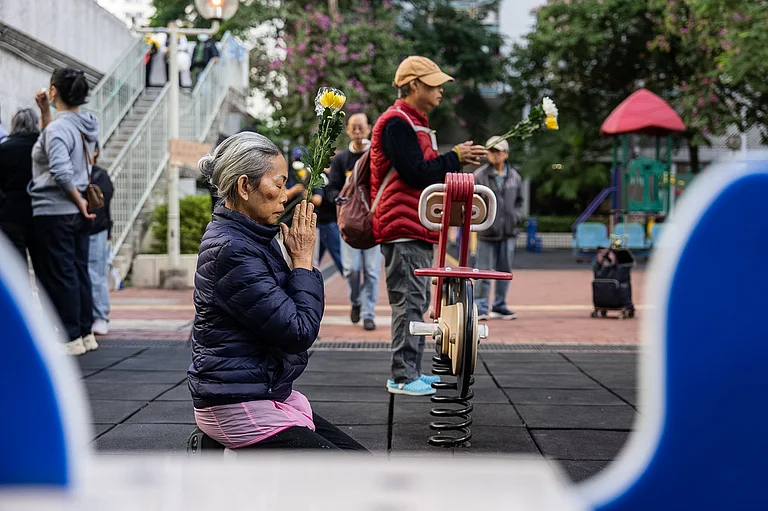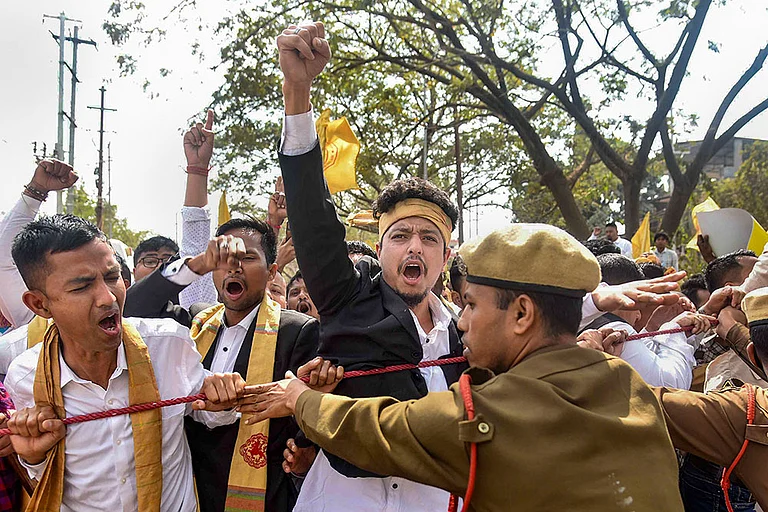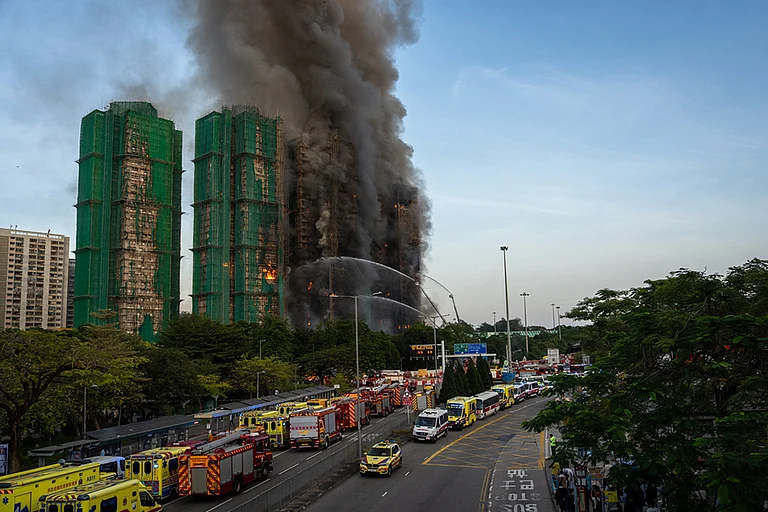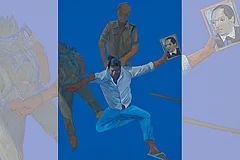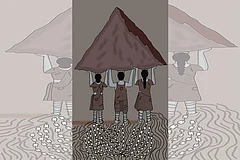“Jamna-gari, naukriyu, khojileyuu hangkaathe,” Tulsi Rajbar, 30, sang in her mother tongue as she patched up the blue walls of her ravaged mud hut in Chakarpur village on the foothills of the Kumaon mountains of Pithoragarh in Uttarakhand. It was a song about migration and search for work in foreign lands, written by Rajbar herself. It is one of the first and only songs ever to be composed in her language, named after her endangered tribe, Raji. “Language is intrinsic to our identity,” Rajbar insisted. A fifth grade passout, Rajbar started learning to read and write in Raji—written in the Devanagari script—in 2021 and soon earned an international fellowship to teach Raji to local children of her community. She had even started writing songs in Raji and had performed them at an event in Dehradun. “I got many invitations and offers from other states at that time, and I thought I could become the first known Raji singer in India,” says Rajbar. That was in 2023.
All that seems to be a distant memory now. Her diary of Raji poems and all her textbooks were washed away in the recent floods that struck her village in July. With no state support for the Raji community or employment opportunities, Rajbar had no option but to return to daily-wage labour, the only work that has been available to her and her forefathers for generations. “Our ancestors left their primitive mountain caves and migrated to the plains for a better life, more farm land and education for our children,” says Rajbar. “We still don’t have pucca houses or jobs,” she says, pointing at her inundated patch of paddy. As an added irony, she says that though she remembers the Raji word for water (ti) and rain (barsaat), she could not recall the word for “floods”. “Maybe they (her ancestors) never faced floods in the hills,” she jokes.
The Rajis got the Scheduled Tribe (ST) status in 1957, and were listed as Particularly Vulnerable Tribal Groups (PVTGs) in 1975 due to their extreme marginality. They speak Raji, one of the hundreds of languages on the cusp of obsolescence in India, endangering not just the community’s methods of communication but also the knowledge about their distinct culture, rituals, practices and perspectives on life. But languages do not die in a vacuum and a closer look at their trajectories reveals a complex interplay of socio-economic and political factors. With a majority of endangered languages originating from indigenous communities, the fate of these languages inadvertently reflects the condition of indigenous or Adivasi communities in India.
“Kings of the Forest”
The snaking Kali River divides the hills of India and Nepal in Pithoragarh, where many of the 1,175 documented Rajis of India stay, spread across 11 remote hamlets. “What’s the use of learning our mother tongue when there are no jobs,” asks Pushpa Devi, mother of a little girl from the remote Altadi village overlooking the river, located about 150 km from Chakarpur and home to about 10 Raji households. The government school in her village shut down a few years ago because there weren’t enough children, forcing those remaining to walk down about five kilometres to the nearest government school. “The young ones don’t speak in proper Raji anymore. Sometimes, they are discouraged from speaking Raji by teachers at school as they feel it hampers the learning of Hindi,” states Pushpa.
Lucknow-based researcher Kavita Rastogi—and former director of the Department of Linguistics at Lucknow University as well as the founder of the Society for Endangered and Lesser-known Languages (SEL)—has been working to save the Raji language from extinction since the 1990s. At that time, there was no written form of the language available, and she found an alarmingly high degree of code mixing and language shifting, indicating loss of language. No one remembers if there ever was any song or chant in their language. “I felt that their basic vocabulary had shifted, meaning they had started using words of the dominant language for body parts or colours, which are often the last to leave a language,” she says. Having produced a basic comparative Raji vocabulary and grammar and also a trilingual dictionary of Raji words, she attributes this shift primarily to the loss of traditional livelihoods.
Languages do not die in a vacuum and a closer look at their trajectories reveals a complex interplay of socio-economic and political factors.
“Discovered” by the British in the 19th century—who immediately labelled them as “jungalee”—the nomadic Rajis were skilled wood carvers. They practiced jhum (shifting) cultivation, hunted langurs and boars and ate in baked wooden utensils they made using wood from the then abundantly available Sagwan tree. The women carved colorful jewellery and the tribe possessed vast knowledge of medicinal plants and botany. “Successive forest and wildlife protection acts deprived them access to wood needed for carving or the animals they hunted,” says Renu Thakur, who runs the Association for Rural Planning and Action (ARPAN), a grassroots organisation working for the socio-legal empowerment of the Rajis. In the course of continuous waves of the so-called ‘modernisation’ and ‘mainstreamisation’ envisaged by successive governments, the Rajis were dragged out of their primitive caves, forced to settle down among other communities and become a part of the ‘civilised’ world, says Thakur. Today, a majority of Rajis live on the margins of urbanisation; only 20 per cent legally own land. Most of their villages lie in rugged regions with no medical or civic facilities. Despite low education levels, most Rajis are trilingual—fluent in Hindi, Kumaoni and Raji—though many refuse to speak their language outside their homes.
“Assimilation” has remained a one-way street. “While the Rajis today worship a variety of Hindu gods and practice rituals like ‘kanyadaan’ in their weddings, they often dissociate from tribal practices that they think make them appear ‘jungalee’,” says the activist. Once known as “Ban Raji” or “Ban Rauth”, most Rajis today feel that “Rauth” is an “insult”. They prefer to be called Raji; want to be spoken to in Hindi; and, refrain from speaking about their past. Even members of the community who try to defy their fate are met with the spectre of bureaucracy, lack or mismanagement of funds allocated for their development, and now, climate change. In 2022, 18-year-old Babita Rajbar from the remote Bhaktirwa village was working with Chakarpur’s Rajbar as a local ambassador leading efforts to revitalise spoken and written Raji language among the youth through weekly Sunday classes and even receiving a small stipend. Funds for the project—which had been financed by Rastogi’s organisation and the international non-profit WikiTongues—dried out after its completion in 2023, and volunteers were left with no option but to quit and focus on other forms of livelihood. “We approached many government primary schools to allow Sunday or even monthly classes, but nothing came of it,” says Babita, an orphan who got married as a minor and is currently completing her high school. A few kilometres below in Kimkhola village, Chandra, 19, agrees. “I was also teaching Raji last year and thought I would become a teacher later. This year, I had to drop out of school because of hardship at home. I now do farm work to support my family while my parents go to work in the city,” she says.
‘Saving’ Languages
Linguistic and cultural heterogeneity was at the heart of the freedom movement and formed the basis for the creation of states in India. As many as 1,652 “mother tongues” were recorded in 1961. Just a decade later, however, in the aftermath of the 1971 Bangladesh Liberation War, the census that year recorded just 109 languages after the government decided to only accept languages with 10,000 or more speakers. While UNESCO lists 197 Indian languages as endangered today, Dharwad-based linguist G N Devy, who undertook the laborious task of surveying over 780 languages for the People’s Linguistic Survey of India, notes that as many as 600 of the “mother tongues” mentioned in Census 2011 are “dying” or in various stages of endangerment.
Devy—who previously argued that the Urdu-Bengali schism in Bangladesh had made many in India concerned about its linguistic multiplicity—states that when it comes to the government, language conservation efforts have been limited to just the “scheduled languages”. “In India, only the 22 scheduled languages that are part of the Eighth Schedule see any serious effort at preservation. And even then, much of it relies on outdated technology like radio programming in an increasingly digitising world,” says Devy, who is founder of the Bhasha Research and Publication Centre.
There is a common belief that a language is endangered when there are very few speakers left speaking that language. That is a limited and rather unscientific view of classifying languages. “What endangers languages is not the lack of speakers or even a native script, but a lack of livelihood opportunities in that language area, leading to outward migration of people from their native regions,” says Devy.
“This is the case with many languages in Bihar, the coastal belt, including Maharashtra and Karnataka, the Himalayan belt, including Himachal Pradesh, Uttarakhand and Sikkim, and most of the northeastern states,” he adds. Devy’s views are supported by Pow Aim Hailowng, a researcher and student from Nam Phake village in Assam and one of the approximately 2,000 members of the Tai Phake tribe. “Even with a script, younger generations might find it difficult to read and write in native tongues as there is no ‘professional utility’ of the language,” says Hailowng.
Conserving a language needs concerted government effort and action, not just in terms of linguistics but also in providing education in mother tongue and livelihood to vulnerable groups in their native places.
Though Assamese is one of the 22 official languages accepted under the Eighth Schedule of the Constitution, Tai Phake, one of the six Tai languages spoken by the Tai tribes in Assam, is not an ‘official language’ or even an ‘unofficial language’ (with over 1 million speakers or between 1 lakh to 1 million speakers). A community of settled rice farmers, the Tai Phake people have been migrating in large numbers to urban centres like Dibrugarh and beyond. With the decline in agricultural profitability and increased contact with other communities, Hailowng, who herself lives in Delhi, feels it won’t be long before the younger generation forgets to even speak the language, meaning parts of her culture would forever be lost to them.
For migrants like Hailowng, who live in cities like Delhi amid shocking cultural and linguistic ignorance towards minority groups, staying “rooted” is a challenge. Hailowng, however, insists that languages can survive orally for many years and one of the ways is through its literature. A student at the Jawaharlal Nehru University, the researcher has been working on translating folk stories and children’s fables from Tai Phake to English. “It’s important to keep the children interested. If not language, at least they can relate to tales and ideas originating in that language,” she says.
Poets to the Rescue
The work of writers, translators and poets has indeed been significant in saving or promoting vulnerable languages. A prime example is the Sambalpuri dialect, also known by its more political name ‘Kosali’. “I was often laughed at for writing songs and poems in Kosali. I was told that it wasn’t a real language,” says popular people’s poet Haldhar Nag from under his favourite banyan tree in Ghens village of western Odisha. Though perfectly adept at understanding Odia, Hindi and English, the poet says he cannot “feel in any language other than Kosali”. The Padma Shri awardee, however, questions why the language was still considered a dialect of Odia.
There are over three million Sambalpuri-Kosali speakers in western Odisha, which is culturally and historically distinct from coastal or other parts of the state, says Nag. Despite petitions and a decade-long movement for the recognition of Kosali as an official state language, the language remains a “novelty”. The mass popularity of Nag’s works due to the efforts of Sambalpuri civil society and government patronage for the author has left a positive impact on the language. But though Sambalpuri has numbers, there is no certainty and a sense of threat pursues its speakers.
Nag insists that a central scheme to implement the Mother Tongue Based Multilingual Education (MTB MLE) is need of the hour for the survival and transfer of vulnerable languages. “There are no avenues for the future growth of the language if it is not taught in schools at the primary level. The National Education Policy talks about teaching mother tongue in schools, but nothing has come of it,” says the poet. The language is not part of the MLE programme adopted by Odisha to protect the educational interests of tribal children. Nag says that the “Sadhana Kutir and Sangrahalaya” that the state government had promised to build in Ghens for research and documentation of the Kosali language has also not materialised as yet.
While revitalisation projects in the past few years have helped some endangered languages like Khasi (which was declared ‘Safe’ by the UNESCO in 2012), and Bhojpuri among others to regain popularity and speakers, hundreds face imminent extinction. In a fast digitising world, almost 90 per cent of India’s languages are yet to be born digitally. Their trajectories show that conserving a language needs concerted government effort and action, not just in terms of linguistics but also in providing education in mother tongue and livelihood to vulnerable groups in their native places. Moreover, it requires the steadfast and often rewardless participation and encouragement of local community leaders like Tulsi Rajbar who is battling climate change and unemployment to the tune of Raji songs, Pow Hailowng populating a concrete jungle with stories of her childhood, or poets like Nag weaving their memories into poetry so that future generations can remember their past.
MORE FROM THIS ISSUE
(This appeared in print as 'Orphaned Languages')







